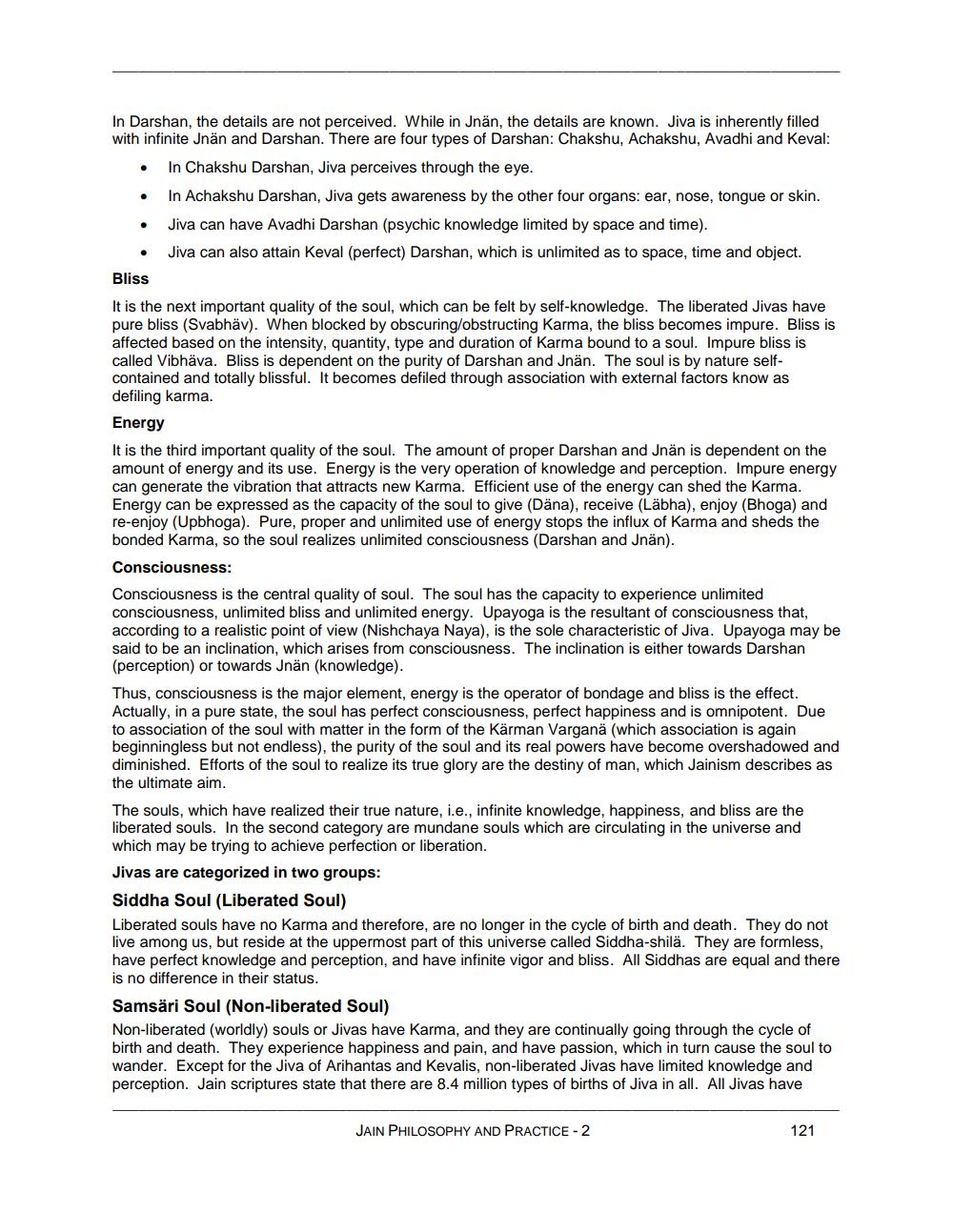________________
In Darshan, the details are not perceived. While in Jnän, the details are known. Jiva is inherently filled with infinite Jnän and Darshan. There are four types of Darshan: Chakshu, Achakshu, Avadhi and Keval:
•
In Chakshu Darshan, Jiva perceives through the eye.
In Achakshu Darshan, Jiva gets awareness by the other four organs: ear, nose, tongue or skin.
•
•
Jiva can have Avadhi Darshan (psychic knowledge limited by space and time).
Jiva can also attain Keval (perfect) Darshan, which is unlimited as to space, time and object.
Bliss
It is the next important quality of the soul, which can be felt by self-knowledge. The liberated Jivas have pure bliss (Svabhäv). When blocked by obscuring/obstructing Karma, the bliss becomes impure. Bliss is affected based on the intensity, quantity, type and duration of Karma bound to a soul. Impure bliss is called Vibhäva. Bliss is dependent on the purity of Darshan and Jnän. The soul is by nature selfcontained and totally blissful. It becomes defiled through association with external factors know as defiling karma.
Energy
It is the third important quality of the soul. The amount of proper Darshan and Jnän is dependent on the amount of energy and its use. Energy is the very operation of knowledge and perception. Impure energy can generate the vibration that attracts new Karma. Efficient use of the energy can shed the Karma. Energy can be expressed as the capacity of the soul to give (Däna), receive (Läbha), enjoy (Bhoga) and re-enjoy (Upbhoga). Pure, proper and unlimited use of energy stops the influx of Karma and sheds the bonded Karma, so the soul realizes unlimited consciousness (Darshan and Jnän).
Consciousness:
Consciousness is the central quality of soul. The soul has the capacity to experience unlimited consciousness, unlimited bliss and unlimited energy. Upayoga is the resultant of consciousness that, according to a realistic point of view (Nishchaya Naya), is the sole characteristic of Jiva. Upayoga may be said to be an inclination, which arises from consciousness. The inclination is either towards Darshan (perception) or towards Jnän (knowledge).
Thus, consciousness is the major element, energy is the operator of bondage and bliss is the effect. Actually, in a pure state, the soul has perfect consciousness, perfect happiness and is omnipotent. Due to association of the soul with matter in the form of the Kärman Varganä (which association is again beginningless but not endless), the purity of the soul and its real powers have become overshadowed and diminished. Efforts of the soul to realize its true glory are the destiny of man, which Jainism describes as the ultimate aim.
The souls, which have realized their true nature, i.e., infinite knowledge, happiness, and bliss are the liberated souls. In the second category are mundane souls which are circulating in the universe and which may be trying to achieve perfection or liberation.
Jivas are categorized in two groups:
Siddha Soul (Liberated Soul)
Liberated souls have no Karma and therefore, are no longer in the cycle of birth and death. They do not live among us, but reside at the uppermost part of this universe called Siddha-shilä. They are formless, have perfect knowledge and perception, and have infinite vigor and bliss. All Siddhas are equal and there is no difference in their status.
Samsäri Soul (Non-liberated Soul)
Non-liberated (worldly) souls or Jivas have Karma, and they are continually going through the cycle of birth and death. They experience happiness and pain, and have passion, which in turn cause the soul to wander. Except for the Jiva of Arihantas and Kevalis, non-liberated Jivas have limited knowledge and perception. Jain scriptures state that there are 8.4 million types of births of Jiva in all. All Jivas have
JAIN PHILOSOPHY AND PRACTICE - 2
121




